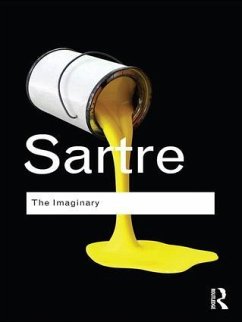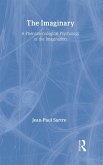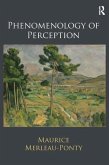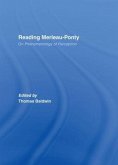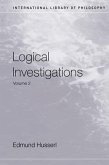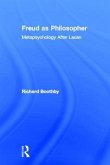- Gebundenes Buch
- Merkliste
- Auf die Merkliste
- Bewerten Bewerten
- Teilen
- Produkt teilen
- Produkterinnerung
- Produkterinnerung
First Published in 2010. Routledge is an imprint of Taylor & Francis, an informa company.
Andere Kunden interessierten sich auch für
![The Imaginary The Imaginary]() Jean-Paul SartreThe Imaginary170,99 €
Jean-Paul SartreThe Imaginary170,99 €![Phenomenology of Perception Phenomenology of Perception]() Maurice Merleau-PontyPhenomenology of Perception90,99 €
Maurice Merleau-PontyPhenomenology of Perception90,99 €![Reading Merleau-Ponty Reading Merleau-Ponty]() Thomas Baldwin (ed.)Reading Merleau-Ponty190,99 €
Thomas Baldwin (ed.)Reading Merleau-Ponty190,99 €![Jean-Paul Sartre Jean-Paul Sartre]() Christine DaigleJean-Paul Sartre36,99 €
Christine DaigleJean-Paul Sartre36,99 €![A Short History of Modern Philosophy A Short History of Modern Philosophy]() Roger ScrutonA Short History of Modern Philosophy151,99 €
Roger ScrutonA Short History of Modern Philosophy151,99 €![Logical Investigations Volume 2 Logical Investigations Volume 2]() Edmund HusserlLogical Investigations Volume 2161,99 €
Edmund HusserlLogical Investigations Volume 2161,99 €![Freud as Philosopher Freud as Philosopher]() Richard BoothbyFreud as Philosopher190,99 €
Richard BoothbyFreud as Philosopher190,99 €-
-
-
First Published in 2010. Routledge is an imprint of Taylor & Francis, an informa company.
Produktdetails
- Produktdetails
- Verlag: Taylor & Francis
- Seitenzahl: 240
- Erscheinungstermin: 1. Dezember 2014
- Englisch
- Abmessung: 216mm x 140mm x 14mm
- Gewicht: 426g
- ISBN-13: 9781138834484
- ISBN-10: 1138834483
- Artikelnr.: 41244663
- Herstellerkennzeichnung
- Libri GmbH
- Europaallee 1
- 36244 Bad Hersfeld
- gpsr@libri.de
- Verlag: Taylor & Francis
- Seitenzahl: 240
- Erscheinungstermin: 1. Dezember 2014
- Englisch
- Abmessung: 216mm x 140mm x 14mm
- Gewicht: 426g
- ISBN-13: 9781138834484
- ISBN-10: 1138834483
- Artikelnr.: 41244663
- Herstellerkennzeichnung
- Libri GmbH
- Europaallee 1
- 36244 Bad Hersfeld
- gpsr@libri.de
Jean-Paul Sartre (1905-80). The foremost French thinker and writer of the early post-war years. His books have exerted enormous influence in philosophy, literature, art and politics.
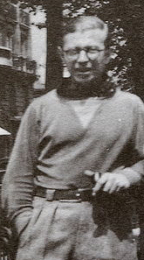
Notes on the Translation Part One: The Certain The Intentional Structure of
the Image I. Description 1. The Method 2. First Characteristic: The Image
is a Consciousness 3. Second Characteristic: The Phenomenon of
Quasi-Observation 4. Third Characteristic: The Imaging Consciousness Posits
its Object as a Nothingness 5. Fourth Characteristic: Spontaneity 6.
Conclusion II. The Image Family 1. Image, Portrait, Caricature 2. Sign and
Portrait 3. From Sign to Image: Consciousness of Imitations 4. From Sign to
Image: Schematic Drawings 5. Faces in the Fire, Spots on Walls, Rocks in
Human Form 6. Hypnagogic Images, Scenes and Persons Seen in Coffee Grounds,
in a Crystal Ball 7. From Portrait to Mental Image 8. Mental Image Part
Two: The Probable Nature of the Analogon in the Mental Image 1. Knowledge
2. Affectivity 3. Movements 4. The Role of the Word in the Mental Image 5.
The Mode of Appearance of a Thing in the Mental Image Part Three: The Role
of the Image in Psychic Life 1. The Symbol 2. Symbolic Schemas and
Illustrations of Thought 3. Image and Thought 4. Image and Perception Part
Four: The Imaginary Life 1. The Irreal Object 2. Conduct in the Face of the
Irreal 3. Pathology of the Imagination 4. The Dream Conclusion 1.
Consciousness and Imagination
the Image I. Description 1. The Method 2. First Characteristic: The Image
is a Consciousness 3. Second Characteristic: The Phenomenon of
Quasi-Observation 4. Third Characteristic: The Imaging Consciousness Posits
its Object as a Nothingness 5. Fourth Characteristic: Spontaneity 6.
Conclusion II. The Image Family 1. Image, Portrait, Caricature 2. Sign and
Portrait 3. From Sign to Image: Consciousness of Imitations 4. From Sign to
Image: Schematic Drawings 5. Faces in the Fire, Spots on Walls, Rocks in
Human Form 6. Hypnagogic Images, Scenes and Persons Seen in Coffee Grounds,
in a Crystal Ball 7. From Portrait to Mental Image 8. Mental Image Part
Two: The Probable Nature of the Analogon in the Mental Image 1. Knowledge
2. Affectivity 3. Movements 4. The Role of the Word in the Mental Image 5.
The Mode of Appearance of a Thing in the Mental Image Part Three: The Role
of the Image in Psychic Life 1. The Symbol 2. Symbolic Schemas and
Illustrations of Thought 3. Image and Thought 4. Image and Perception Part
Four: The Imaginary Life 1. The Irreal Object 2. Conduct in the Face of the
Irreal 3. Pathology of the Imagination 4. The Dream Conclusion 1.
Consciousness and Imagination
Notes on the Translation Part One: The Certain The Intentional Structure of the Image I. Description 1. The Method 2. First Characteristic: The Image is a Consciousness 3. Second Characteristic: The Phenomenon of Quasi-Observation 4. Third Characteristic: The Imaging Consciousness Posits its Object as a Nothingness 5. Fourth Characteristic: Spontaneity 6. Conclusion II. The Image Family 1. Image, Portrait, Caricature 2. Sign and Portrait 3. From Sign to Image: Consciousness of Imitations 4. From Sign to Image: Schematic Drawings 5. Faces in the Fire, Spots on Walls, Rocks in Human Form 6. Hypnagogic Images, Scenes and Persons Seen in Coffee Grounds, in a Crystal Ball 7. From Portrait to Mental Image 8. Mental Image Part Two: The Probable Nature of the Analogon in the Mental Image 1. Knowledge 2. Affectivity 3. Movements 4. The Role of the Word in the Mental Image 5. The Mode of Appearance of a Thing in the Mental Image Part Three: The Role of the Image in Psychic Life 1. The Symbol 2. Symbolic Schemas and Illustrations of Thought 3. Image and Thought 4. Image and Perception Part Four: The Imaginary Life 1. The Irreal Object 2. Conduct in the Face of the Irreal 3. Pathology of the Imagination 4. The Dream Conclusion 1. Consciousness and Imagination
Notes on the Translation Part One: The Certain The Intentional Structure of
the Image I. Description 1. The Method 2. First Characteristic: The Image
is a Consciousness 3. Second Characteristic: The Phenomenon of
Quasi-Observation 4. Third Characteristic: The Imaging Consciousness Posits
its Object as a Nothingness 5. Fourth Characteristic: Spontaneity 6.
Conclusion II. The Image Family 1. Image, Portrait, Caricature 2. Sign and
Portrait 3. From Sign to Image: Consciousness of Imitations 4. From Sign to
Image: Schematic Drawings 5. Faces in the Fire, Spots on Walls, Rocks in
Human Form 6. Hypnagogic Images, Scenes and Persons Seen in Coffee Grounds,
in a Crystal Ball 7. From Portrait to Mental Image 8. Mental Image Part
Two: The Probable Nature of the Analogon in the Mental Image 1. Knowledge
2. Affectivity 3. Movements 4. The Role of the Word in the Mental Image 5.
The Mode of Appearance of a Thing in the Mental Image Part Three: The Role
of the Image in Psychic Life 1. The Symbol 2. Symbolic Schemas and
Illustrations of Thought 3. Image and Thought 4. Image and Perception Part
Four: The Imaginary Life 1. The Irreal Object 2. Conduct in the Face of the
Irreal 3. Pathology of the Imagination 4. The Dream Conclusion 1.
Consciousness and Imagination
the Image I. Description 1. The Method 2. First Characteristic: The Image
is a Consciousness 3. Second Characteristic: The Phenomenon of
Quasi-Observation 4. Third Characteristic: The Imaging Consciousness Posits
its Object as a Nothingness 5. Fourth Characteristic: Spontaneity 6.
Conclusion II. The Image Family 1. Image, Portrait, Caricature 2. Sign and
Portrait 3. From Sign to Image: Consciousness of Imitations 4. From Sign to
Image: Schematic Drawings 5. Faces in the Fire, Spots on Walls, Rocks in
Human Form 6. Hypnagogic Images, Scenes and Persons Seen in Coffee Grounds,
in a Crystal Ball 7. From Portrait to Mental Image 8. Mental Image Part
Two: The Probable Nature of the Analogon in the Mental Image 1. Knowledge
2. Affectivity 3. Movements 4. The Role of the Word in the Mental Image 5.
The Mode of Appearance of a Thing in the Mental Image Part Three: The Role
of the Image in Psychic Life 1. The Symbol 2. Symbolic Schemas and
Illustrations of Thought 3. Image and Thought 4. Image and Perception Part
Four: The Imaginary Life 1. The Irreal Object 2. Conduct in the Face of the
Irreal 3. Pathology of the Imagination 4. The Dream Conclusion 1.
Consciousness and Imagination
Notes on the Translation Part One: The Certain The Intentional Structure of the Image I. Description 1. The Method 2. First Characteristic: The Image is a Consciousness 3. Second Characteristic: The Phenomenon of Quasi-Observation 4. Third Characteristic: The Imaging Consciousness Posits its Object as a Nothingness 5. Fourth Characteristic: Spontaneity 6. Conclusion II. The Image Family 1. Image, Portrait, Caricature 2. Sign and Portrait 3. From Sign to Image: Consciousness of Imitations 4. From Sign to Image: Schematic Drawings 5. Faces in the Fire, Spots on Walls, Rocks in Human Form 6. Hypnagogic Images, Scenes and Persons Seen in Coffee Grounds, in a Crystal Ball 7. From Portrait to Mental Image 8. Mental Image Part Two: The Probable Nature of the Analogon in the Mental Image 1. Knowledge 2. Affectivity 3. Movements 4. The Role of the Word in the Mental Image 5. The Mode of Appearance of a Thing in the Mental Image Part Three: The Role of the Image in Psychic Life 1. The Symbol 2. Symbolic Schemas and Illustrations of Thought 3. Image and Thought 4. Image and Perception Part Four: The Imaginary Life 1. The Irreal Object 2. Conduct in the Face of the Irreal 3. Pathology of the Imagination 4. The Dream Conclusion 1. Consciousness and Imagination

